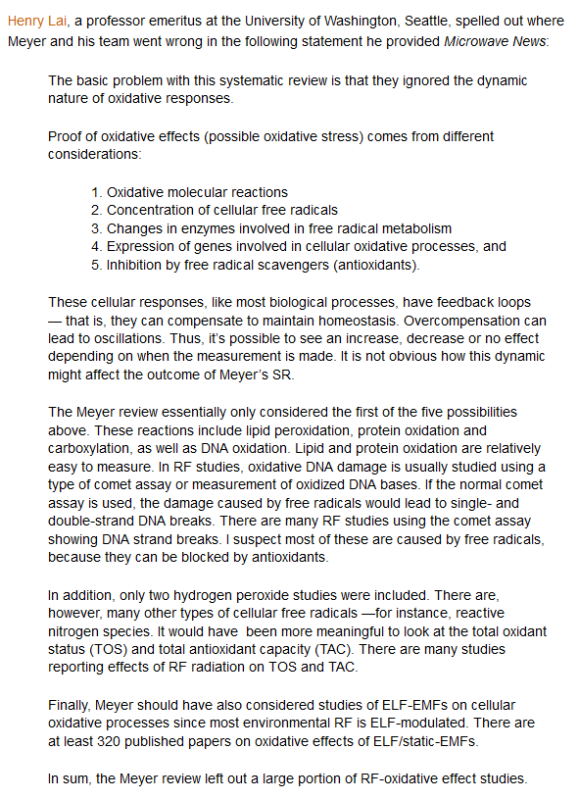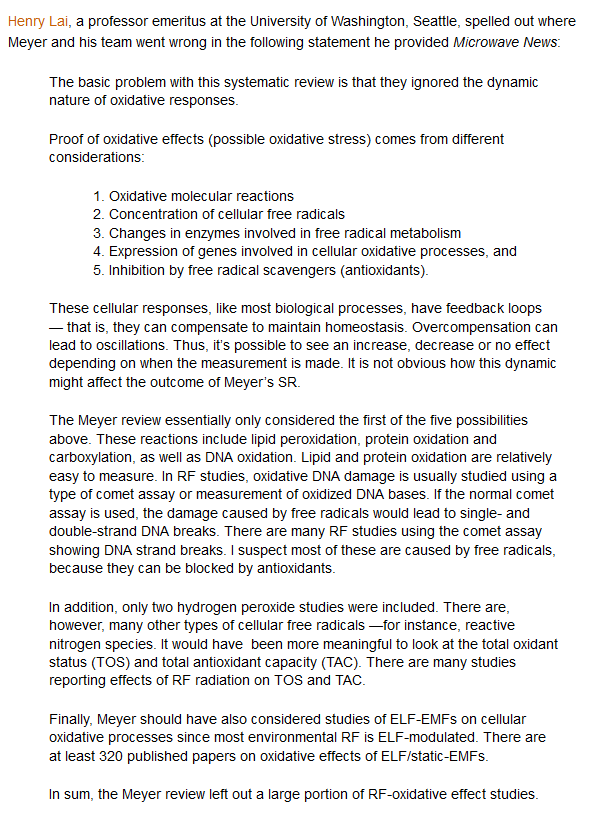In the ongoing debate surrounding the health effects of radiofrequency electromagnetic fields (RF-EMF), the World Health Organization (WHO) has played a central role in shaping public policy and health recommendations. However, the organization’s recent systematic review on RF-induced oxidative stress has sparked controversy and criticism from leading researchers in the field. Notably, Henry Lai, a professor emeritus at the University of Washington, has voiced strong concerns regarding the methodology and conclusions of the WHO review.
In this comprehensive blog post, we will delve into the main points of contention surrounding the WHO’s review, analyze Henry Lai’s critique, and explore the broader implications of this debate for public health and safety.

The Controversy Surrounding the WHO’s RF-EMF Review
The WHO’s systematic review on RF-induced oxidative stress, led by Felix Meyer from the German Office for Radiation Protection (BfS), has come under fire for its exclusionary criteria. The review team identified 11,599 studies on oxidative stress within the frequency range of 800-2450 MHz but ultimately included only 56 studies in their analysis. The authors concluded that the effects of RF-EMF exposure were “inconsistent across studies” and that the certainty of the evidence was “very low.”
Why Was the Review Criticized?
The review has been met with skepticism, particularly from experts who are not affiliated with the WHO, ICNIRP (International Commission on Non-Ionizing Radiation Protection), or the BfS. Critics argue that the review systematically excluded most of the relevant research, leading to a skewed and incomplete assessment of the health risks associated with RF-EMF exposure.
Joel Moskowitz of the UC Berkeley School of Public Health was among the first to voice concerns, stating in an interview with Microwave News that “a strong case can be made that the Meyer review should be retracted.” This sentiment is shared by other researchers who believe that the review’s narrow focus and exclusionary criteria undermine its conclusions.
Henry Lai’s Critique: Where the WHO Review Went Wrong
Henry Lai, a prominent researcher in the field of electromagnetic radiation and oxidative stress, provided a detailed critique of the WHO review. According to Lai, the fundamental flaw in the review lies in its failure to account for the dynamic nature of oxidative responses in biological systems.
The Dynamic Nature of Oxidative Responses
Lai argues that oxidative stress is a complex, multifaceted process that cannot be fully understood by examining only one aspect of oxidative reactions. He identifies five key areas that should be considered when assessing oxidative stress:
- Oxidative Molecular Reactions: These include processes such as lipid peroxidation, protein oxidation, and DNA oxidation. These reactions are relatively easy to measure and are often the primary focus in studies of oxidative stress.
- Concentration of Cellular Free Radicals: Free radicals, including reactive oxygen species (ROS) and reactive nitrogen species (RNS), play a crucial role in oxidative stress. Measuring the concentration of these radicals provides insight into the oxidative state of cells.
- Changes in Enzymes Involved in Free Radical Metabolism: Enzymes such as superoxide dismutase (SOD) and catalase are involved in the detoxification of free radicals. Changes in the activity of these enzymes can indicate oxidative stress.
- Expression of Genes Involved in Cellular Oxidative Processes: The expression of genes that regulate oxidative processes can provide a deeper understanding of how cells respond to oxidative stress.
- Inhibition by Free Radical Scavengers (Antioxidants): The presence and activity of antioxidants are crucial in mitigating oxidative damage. Studies that examine the effects of antioxidants on RF-induced oxidative stress are particularly valuable.
According to Lai, the Meyer review focused almost exclusively on the first category—oxidative molecular reactions—while largely ignoring the other four. This narrow focus, Lai contends, leads to an incomplete and potentially misleading assessment of the effects of RF-EMF exposure.
The Importance of Comprehensive Analysis
Lai emphasizes that oxidative responses are not static; they involve feedback loops that can lead to compensatory mechanisms and oscillations in cellular processes. This dynamic nature means that the timing of measurements is critical. Depending on when oxidative stress is measured, researchers may observe an increase, decrease, or no change in oxidative markers. Lai argues that the WHO review failed to account for this complexity, leading to the erroneous conclusion that the effects of RF-EMF exposure are inconsistent.
What the WHO Review Missed: A Broader Perspective on Oxidative Stress
Lai’s critique highlights several specific areas where the WHO review fell short:
The Exclusion of Relevant Studies
The Meyer review included only 56 studies out of the 11,599 initially identified. Lai points out that this exclusionary approach overlooked a significant body of research that could have provided a more comprehensive understanding of RF-induced oxidative stress. Notably, Lai’s own bibliography on RF-oxidative stress includes 367 studies published between 1997 and 2024, of which 89% reported significant effects.
The Neglect of Total Oxidant Status (TOS) and Total Antioxidant Capacity (TAC)
Lai criticizes the review for not considering studies that examined the total oxidant status (TOS) and total antioxidant capacity (TAC) in cells. These measures provide a more holistic view of the oxidative balance within cells and are crucial for understanding the overall impact of RF-EMF exposure.
The Overlooked Role of ELF-EMFs
Lai also notes that the review did not adequately consider the effects of extremely low-frequency electromagnetic fields (ELF-EMFs) on oxidative processes. Given that most environmental RF is modulated by ELF frequencies, this omission represents a significant gap in the review’s analysis.
The Implications of Flawed Reviews: Why It Matters
The WHO’s systematic reviews are part of a decade-long process to update its guidelines on RF health effects. These guidelines are used by policymakers, public health officials, and researchers worldwide to assess the safety of RF-EMF exposure. If these reviews are flawed, as Lai and others suggest, the resulting guidelines could be inadequate, potentially leaving the public at risk.
The Need for Transparency and Comprehensive Research
Lai’s critique underscores the importance of transparency and comprehensive analysis in scientific research. When conducting systematic reviews, it is essential to consider the full spectrum of available evidence and to account for the complexity of biological processes. Failing to do so can lead to misleading conclusions and, ultimately, to public health policies that do not adequately protect the public.
Conclusion: Moving Forward with Caution
The controversy surrounding the WHO’s review on RF-induced oxidative stress highlights the need for a cautious and thorough approach to assessing the health risks of RF-EMF exposure. As Lai’s critique demonstrates, the complexity of oxidative stress requires a comprehensive analysis that considers all relevant factors, including the dynamic nature of oxidative responses, the role of free radicals, and the broader context of RF-EMF exposure.
As we move forward, it is crucial that researchers, policymakers, and public health officials take these concerns seriously. By ensuring that systematic reviews are conducted with rigor and transparency, we can better protect public health and make informed decisions about the safety of RF-EMF exposure.
Acknowledgments
Special thanks to Henry Lai, Professor Emeritus at the University of Washington, for his invaluable insights and contributions to this analysis. His work continues to shed light on the complex interactions between electromagnetic fields and biological systems, and his critique of the WHO review serves as a critical reminder of the importance of thorough and transparent scientific research.
Call to Action
Given the significant concerns raised by Henry Lai and others, it is imperative that the scientific community and public health authorities revisit the WHO’s systematic reviews on RF-EMF. By advocating for more comprehensive and transparent research, we can ensure that public health policies are based on a complete and accurate understanding of the risks associated with RF-EMF exposure.
We encourage readers to stay informed and to support efforts to promote rigorous scientific research in this critical area. Public health and safety depend on it.
Further Reading
For those interested in learning more about the health effects of RF-EMF exposure and the ongoing debate, we recommend the following resources:
- Microwave News: WHO RF-EMF Review on Oxidative Stress
- Electromagnetic Radiation Safety: Joel Moskowitz’s Analysis
- Henry Lai’s Bibliography on RF-Oxidative Stress Papers (1997-2024)
Webmaster Notice: Urgent Call for Action on RF-EMF Health Risks
Our collective health and safety are under significant threat due to recent decisions that have critically impacted essential health research and safety regulations. The latest WHO review on RF-EMF-induced oxidative stress, as discussed in the blog post, highlights the flaws and gaps in current scientific assessments. It is imperative that we address these issues by advocating for stronger, more comprehensive research and updated safety guidelines.
The cessation of crucial health research by the National Toxicology Program (NTP) and the outdated Federal Communications Commission (FCC) safety guidelines on electromagnetic radiation are matters of grave concern. There is an overwhelming body of research, including studies on oxidative stress and the harmful effects of RF-EMF, that suggests significant health risks associated with prolonged exposure to cell phone radiation and other wireless technologies.
As Henry Lai’s critique shows, the current WHO review fails to account for the full spectrum of evidence, particularly in understanding the dynamic and complex nature of oxidative stress. This oversight could lead to inadequate safety measures, leaving the public vulnerable to potential health risks.
Restore NTP Funding for Critical Health Research
The NTP has been at the forefront of researching the health impacts of electromagnetic radiation, providing clear evidence of cancer risks associated with RF-EMF exposure. The discontinuation of this research due to funding constraints is a critical loss that needs immediate attention. Restoring NTP funding is essential to continue investigating the long-term health effects of RF-EMF exposure and to advance bioelectric medicine, which holds the potential for groundbreaking treatments.
Update FCC Safety Guidelines
The FCC’s safety guidelines for RF radiation, established in 1996, have not been updated to reflect recent scientific findings. A recent court ruling emphasized that the FCC has failed to address the health effects of RF radiation beyond cancer, including impacts on reproductive health, neurological function, and children’s health. The research highlighted in the blog post further underscores the need for caution in dismissing these potential risks.
Non-Thermal Effects and Therapeutic Potential
The blog post discusses how recent advancements in RF radiation research reveal biological interactions beyond thermal effects. For example, the FDA-approved TheraBionic treatment demonstrates the potential for RF-EMF to treat cancer through non-thermal interactions at the cellular level. This challenges the outdated view that non-ionizing cell phone radiation is harmless aside from its heating properties. The outdated FCC guidelines must be updated to protect public health adequately.
Take Action
We urge you to join us in taking action. Advocate for the restoration of NTP funding and demand the update of FCC safety guidelines. Your voice is crucial in ensuring that public health policies are based on a comprehensive and accurate understanding of the risks associated with RF-EMF exposure.
Together, we can ensure a healthier future for all by pushing for rigorous and transparent research, as well as updated safety standards that truly protect the well-being of our communities. Let’s unite in this effort and demonstrate our commitment to safeguarding public health.
Stay informed, stay safe, and let’s work together to bring about the changes needed to protect our health from the potential dangers of RF-EMF exposure.








